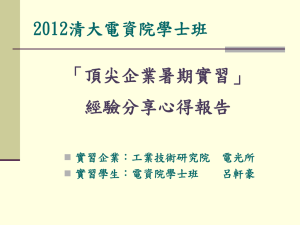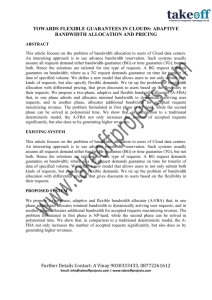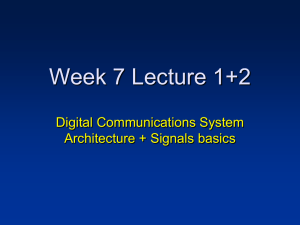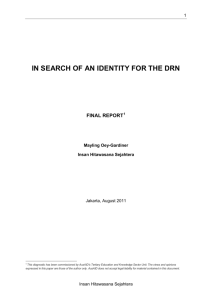jgra51391-sup-0002-txts01
advertisement
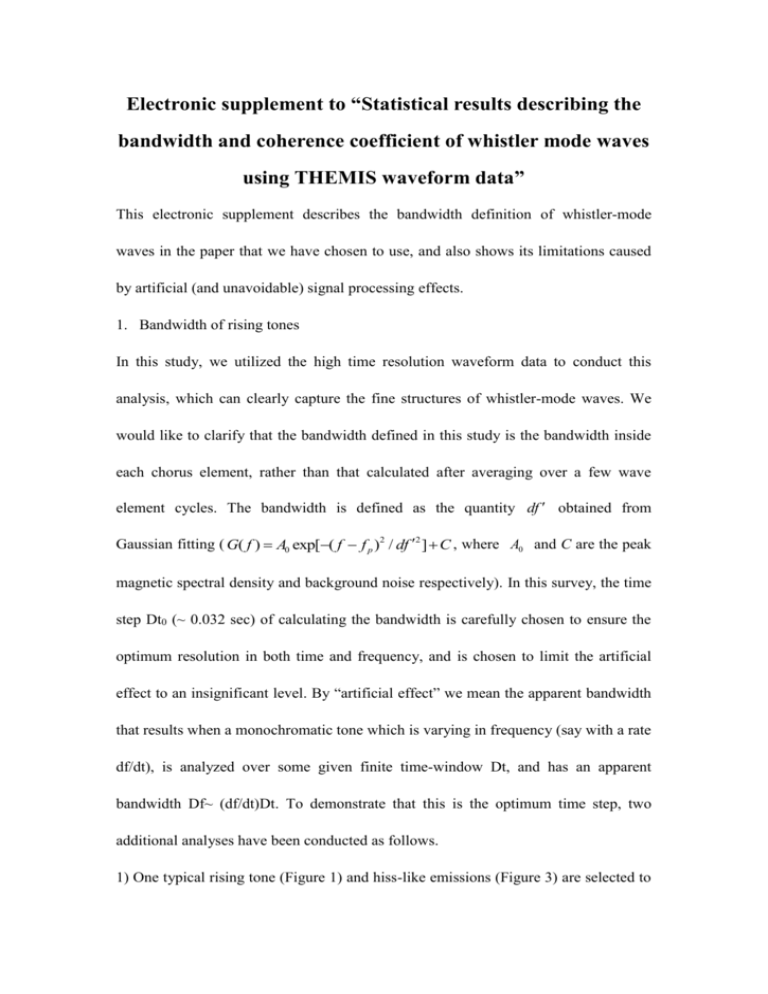
Electronic supplement to “Statistical results describing the bandwidth and coherence coefficient of whistler mode waves using THEMIS waveform data” This electronic supplement describes the bandwidth definition of whistler-mode waves in the paper that we have chosen to use, and also shows its limitations caused by artificial (and unavoidable) signal processing effects. 1. Bandwidth of rising tones In this study, we utilized the high time resolution waveform data to conduct this analysis, which can clearly capture the fine structures of whistler-mode waves. We would like to clarify that the bandwidth defined in this study is the bandwidth inside each chorus element, rather than that calculated after averaging over a few wave element cycles. The bandwidth is defined as the quantity df obtained from Gaussian fitting ( G( f ) A0 exp[( f f p )2 / df 2 ] C , where A0 and C are the peak magnetic spectral density and background noise respectively). In this survey, the time step Dt0 (~ 0.032 sec) of calculating the bandwidth is carefully chosen to ensure the optimum resolution in both time and frequency, and is chosen to limit the artificial effect to an insignificant level. By “artificial effect” we mean the apparent bandwidth that results when a monochromatic tone which is varying in frequency (say with a rate df/dt), is analyzed over some given finite time-window Dt, and has an apparent bandwidth Df~ (df/dt)Dt. To demonstrate that this is the optimum time step, two additional analyses have been conducted as follows. 1) One typical rising tone (Figure 1) and hiss-like emissions (Figure 3) are selected to show how their bandwidths vary by choosing different values of time step Dt. The results are shown in Figure S1. For hiss-like emissions, the bandwidth stays nearly unchanged with the increase in time step. This is to be expected, since the hiss-like emission does not contain a chirping rate (i.e., some finite df/dt), and its bandwidth should not depend on the time interval selected. As shown in Figure S1, the bandwidth of the hiss-like emission only increases by 20% even when the time step increases to 5 Dt0. However, for the rising tone, two different trends can be found before and after the vertical red arrow. When the time step is smaller than 2 Dt0, the increase of bandwidth is quite small. However, when the time step exceeds 2 Dt0, the bandwidth increases rapidly with the increase of time step due to the chirping rate. For example, when the time step is 4.25 Dt0, the bandwidth increases up to 2.3 Df0. Therefore, for the hiss-like emission, the effect of time step on the bandwidth is insignificant. However, for the rising tone, the chirp rate affects the calculation of bandwidth when the time step is larger than 2 Dt0, whereas this artificial effect is limited to a very low level when the time step is chosen to be small (< 2 Dt 0). So our goal is to select a time step that is as small as possible, so that the effects of the “chirp” (a finite df/dt) are minimized and only the “intrinsic bandwidth” of the chorus element remains. 2) To quantitatively show the artificial effects introduced due to the different frequency sweep rates df/dt, we construct a time waveform y(t)=cos(ft), where f is a linearly increasing frequency (f=(df/dt)t+f0). The sampling rate of y(t) is chosen so that it is almost the same as that of the THEMIS waveform data (~ 8000 Hz). Then the same analysis technique as in the paper is utilized for this artificial rising tone to show how much artificial bandwidth we can get, which is demonstrated in Figure S2. For each time step group, there are actually two factors controlling the artificial bandwidth. In the region with smaller df/dt, the artificial bandwidth is dominated by the frequency resolution (since frequency resolution is proportional to 1/Dt). However, when the df/dt exceeds some value (turning point), the artificial bandwidth is dominated by the drift frequency (or low time resolution). Besides, the turning point of df/dt of these two effects decreases with the increase of time step. The observational results of rising tones are also over plotted in Figure S2 on top of the bandwidth calculated for the time step of Dt0 (red solid line), 2 Dt0 (blue dotted line), and 0.5 Dt0 (blue dashed line). If a wave event is located below the corresponding line, its bandwidth is assumed to be significantly affected by artificial effects. For Dt0, 2 Dt0, and 0.5 Dt0, there are about 3%, 17%, and 76% of wave events potentially significantly contaminated by artificial effects. Therefore, the time step chosen in our paper (Dt0) is the optimum one, which can provide optimum resolution in both time and frequency, and minimize the artificial bandwidth by either the df/dt of the signal or a coarse frequency resolution. In addition, it is worth noting that the artificial effects may be overestimated in this test study. Because in realistic cases, more frequency bins rather than only those caused by df/dt are involved in the Gaussian fitting, which is combined together to determine the shape of the Gaussian fitting function. 2. Bandwidth of hiss-like emissions In the paper, the bandwidth is calculated by Gaussian fitting at each time step, then averaged over the entire event. Another possible way to calculate the bandwidth of hiss-like emissions is to average the spectra over the entire event before performing the Gaussian fitting. To compare these two methods, the bandwidths of all hiss-like emissions are also calculated after averaging the power spectra over the entire event, and then over plotted in the previous panels. The results are shown in Figure S3. We found that the distribution of blue points becomes more scattered, and some hiss-like events now have larger bandwidths possibly due to the strong fluctuations of peak frequencies which could be counted as part of the bandwidth after averaging the spectra. However, the majority of blue points still overlap with original results (black points), and the dependences of the bandwidth on other parameters keep nearly unchanged except the dependence of df/fce on the plasma density which is caused by the overestimated bandwidths for events with high plasma densities. In addition, we note that the bandwidth in our study is intended for the conceptual purpose of determining whether the local electron scattering is stochastic or deterministic, which is different from the bandwidth typically calculated by averaging the long-time spectrum first in previous works [e.g., Horne et al., 2005; Li et al., 2007; Su et al., 2009]. Furthermore, we prefer to use the same definition of “bandwidth” for rising/falling tones and hiss-like emissions for consistency. Therefore, the first method is chosen to be used in the paper.


